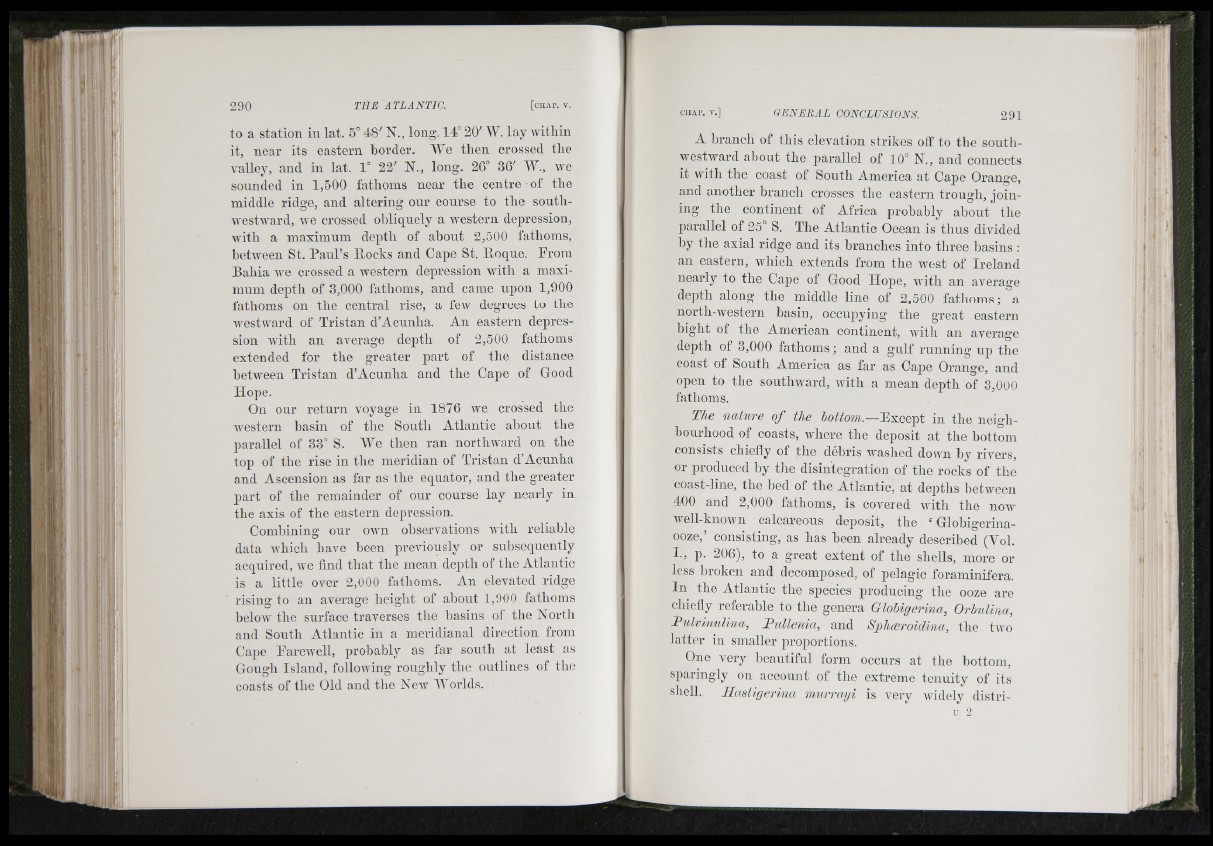
' . r i ' ¡G v :
I i
IGi.,
-Mt ■?
AS'
l! i:
tol'ltf'
G tinto
a station in lat. 5° 48' N., long. 14° 20' W. lay within
it, near its eastern border. We then crossed the
valley, and in lat. 1° 22' N., long. 26° 36' W., we
sonnded in 1,500 fathoms near the centre of the
middle ridge, and altering onr course to the sonth-
Avestward, Ave crossed obliquely a Avestern depression,
with a maximum depth of ahont 2,500 fathoms,
hetAveen St. Paul’s Rocks and Cape St. Roque. Prom
Bahia we crossed a western depression Avith a maximum
depth of 3,000 fathoms, and came npon 1,900
fatlioms on the central rise, a feiv degrees to the
AvestAvard of Tristan d’Acunha. An eastern depression
Avith an average depth of 2,500 fathoms
extended for the greater part of the distance
betAveen Tristan d’Acunha and the Cape of Good
Hope.
On our return voyage in 1876 we crossed the
Avestern basin of tlie Sontli Atlantic ahout the
parallel of 33° S. We then ran nortliAA^ard on the
top of the rise in the meridian of Tristan d’Acnnha
and Ascension as far as the equator, and the greater
part of the remainder of onr course lay nearly in
the axis of the eastern depression.
Comhinino; onr OAvn ohserA-'ations Avith reliable
data Avbicb have been previously or subsequently
acquired, Ave find that the mean depth of the Atlantic
is a little OAmr 2,000 fathoms. An elevated ridge
rising to an average height of about 1,900 fathoms
beloAV the surface traverses tiie basins of the North
and Sontli Atlantic in a meridianal direction from
Cape PareAveli, probably as far south at least as
Gongb Island, foiloAving rongiily the outlines of tbe
coasts of tbe Old and tbe New Worlds.
A branch of tbis elevation strikes ofi‘ to tbe south-
Avestward about tbe parallel of 10° N., and connects
it witli the coast of South America at Cape Orange,
and another branch crosses the eastern trough, joining
tbe continent of Africa probably about the
parallel of 25 S. The Atlantic Ocean is thus divided
by the axial ridge and its branches into three basins :
an eastern, Avhich extends from the Avest of Ireland
nearly to the Cape of Good Hope, Avith an average
depth along the middle line of 2,500 fathoms; a
north-western basin, occupying tbe great eastern
bight of tbe American continent, Avitb an average
depth of 3,000 fathoms ; and a gulf running up the
coast of South America as far as Cape Orange, and
open to the southward, Avith a mean depth of 3,000
fathoms.
The nature of the Except in the neigbbourhood
of coasts, Avhere tbe deposit at the bottom
consists chiefly of the débris Avasbed down by rivers,
or produced by tbe disintegration of tbe rocks of tbe
coast-line, the bed of tbe Atlantic, at depths between
400 and 2,000 fathoms, is covered AAutli the iioav
Avell-knoAvn calcareous deposit, the ‘ Globigerina-
ooze,’ consisting, as has been already described (Vol.
I., ]3. 206), to a great extent of tbe shells, more or
less broken and decomposed, of pelagic foraminiiera.
In tbe Atlantic tbe species producing tbe ooze are
chiefly referable to tbe genera Globigerina, Orbulina,
Tulvinulina, Tullenia, and Sphoeroidina, tbe tAvo
latter in smaller proportions.
One very beautiful form occurs at tbe bottom,
sparingly on account of tbe extreme tenuity of its
shell. Hastigerina murrayi is very Avidely distriu
2